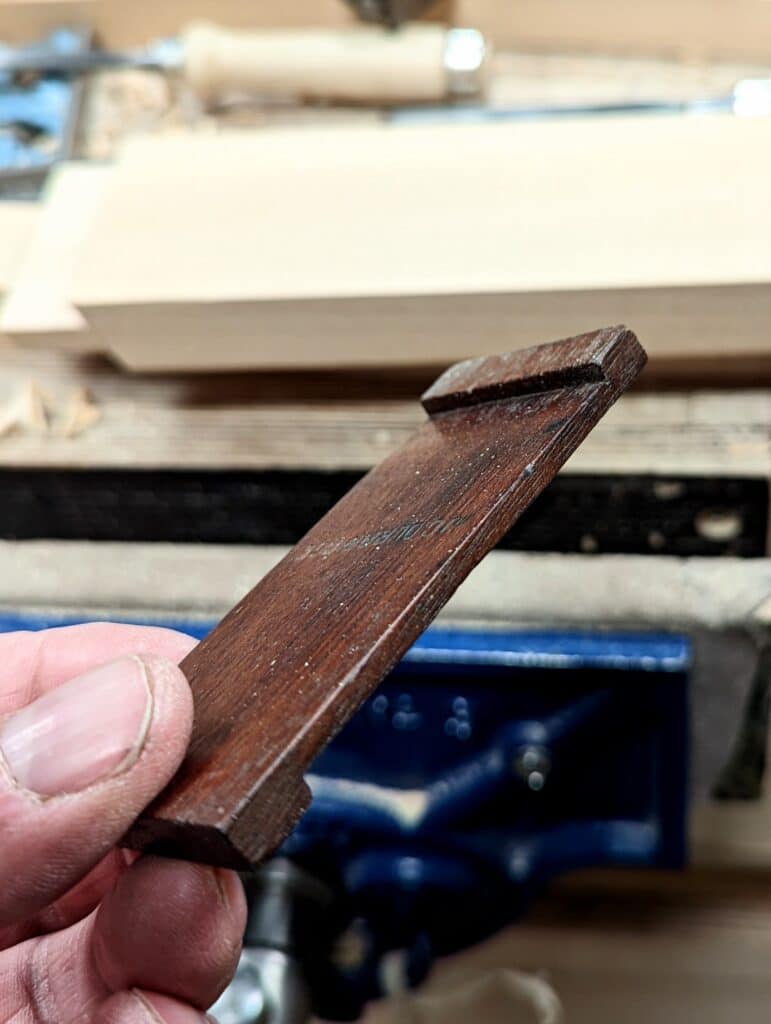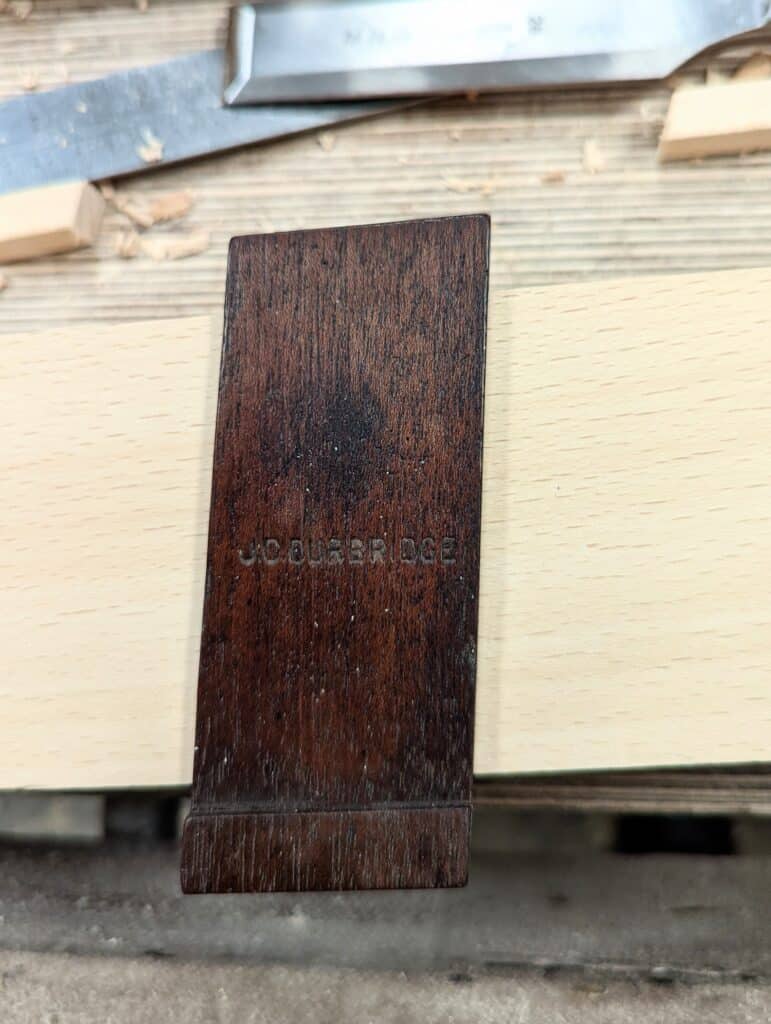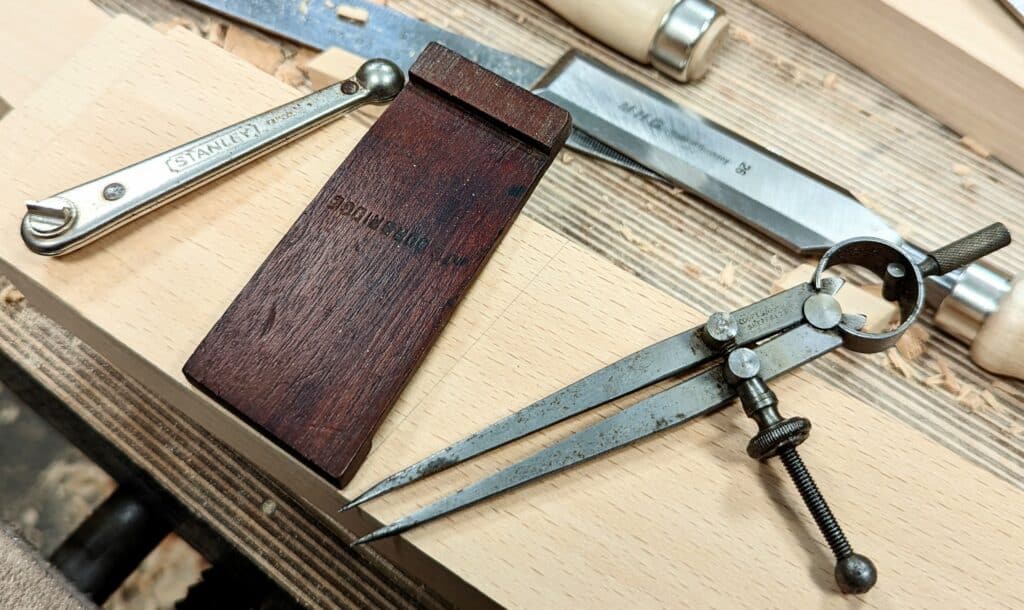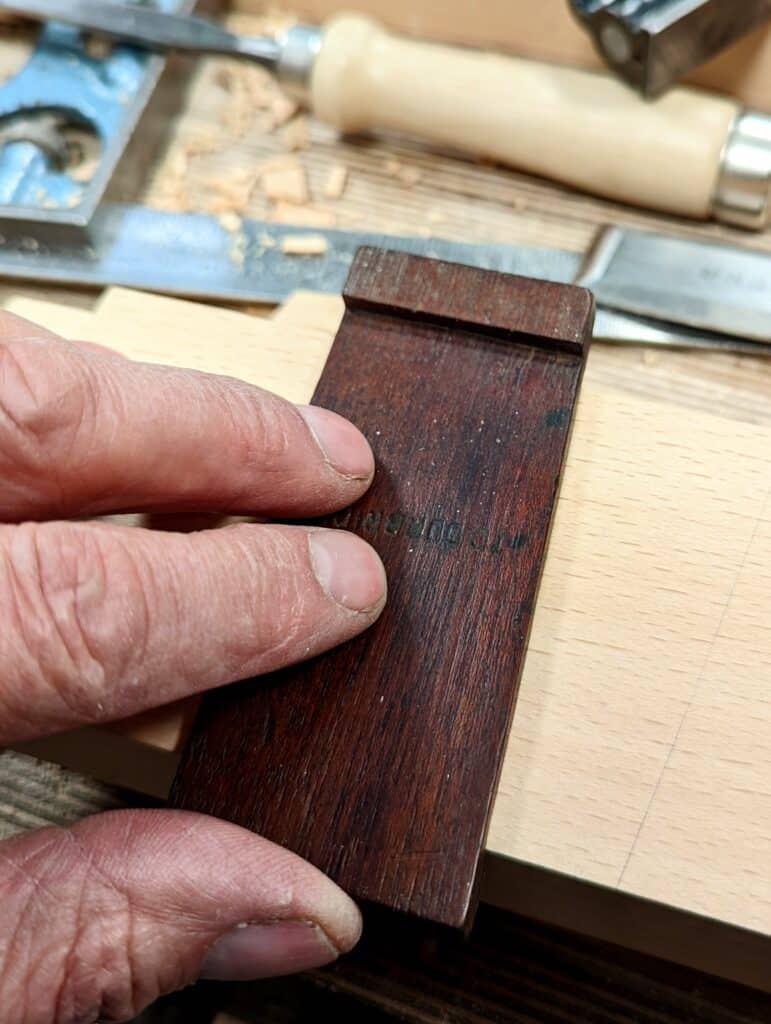Lost and found

In the bottom of a red plastic box lay the abandoned tools of people. My eye rested on a dark piece of wood with a narrow lip along it, so I lifted it from the rest and said to John, “A dovetail template!” I tumbled it between the fingers and thumbs of my two hands and recorded the name of my maker by speaking out his name, “J C Durbridge!” It was a declaration. I knew that. It had meant something at one time, to the man, I mean. The man that made it. It had meaning!

It was the thinness and the length of it that seemed to me a significant thing. But then too I saw a certain precision to the maker’s hand, a crispness to his output that’s needed for a piece like this, you know, a layout tool. The sign on the red box, written with a large Sharpie on white paper, said two pounds per item and I took three pieces to the counter and the lady said, “Two pounds.” This was nearer the fairer price for the three things I supposed, but I felt that the dovetail template, while of historical significance, antiquity, and such, was worth the two pounds to me. Whereas I didn’t altogether want to pay two pounds for it, I did so anyway, rather than see it remain in the bottom of a red plastic box with no one knowing what it was.

So now you have it. It’s mine, for a season at any rate, this rarer find of almost discarded wood. These oft abandoned, nameless orphans seldom find a home nor ongoing use. You don’t find dovetail templates very often, even, I can say, in a whole lifetime of working wood. Especially do you not find the well-used ones with the name of a maker stamped in and that’s because the family most likely have no idea what they’re dad, granddad or great granddad used it for. Most children and grandchildren have no clue of their father’s craft in terms of how they did it, where they worked, things like that. He’s usually a man that leaves around seven in the morning and remains unseen until six or seven each day. So I look at this well-worn, man-made thing and think of Mr. J C Durbridge marking out his thousandth dovetails with a pencil freshly sharpened. How he lifts his dovetail saw to cut to the angled lines dead-square across and lines his eye up to the saw plate, squints a little to focus, and then slice-cuts parallel to his lines. Really, it’s the kind of thing I’d keep if it was my dad’s. Even if I didn’t know what it did.

I can’t recall the last one I found. I didn’t really need another today, but there it was looking for a home from its abandoned state in a red plastic box in a secondhand shop. My own dovetail template is the best yet and especially my newest and very latest iteration of it that just came back from an engineer friend who fabricated some prototypes to my specs. One day it will be available because I think it is such a nice one to use. This mahogany one I found will join my dozen or so others and I will enjoy using it from time to time, maybe.
Really, such found things are true treasures to a man- and a woman-maker because the treasure in its use becomes a treasured thought where a man like me enjoys his isolated thinking at the bench where he works in his own silence and mostly alone in his own isolation where he thinks expansively.


Hi Paul, I think you should make a small box using this template and call it your durbridge box – you could keep the template in it.
Wooden handles are often marked with initials. I suppose they come from a working environment and are marked to prevent the accident of placement into another’s box. History in my hands.
Oh, hmm! Accidental placement can easily be translated as intensional stealing, Andrew. Just saying. It’s happened more than once with my tools.
Sometimes they were marked with tally marks or Roman numerals. I have several tools that belonged to either my grandfather or great grandfather marked that way.
The name stamps being hand made were probably expensive, I have one from my grandfather or great grandfather where the initial letter has been ground off to allow it to be used by a later generation.
I have one very similar, regularly used, came in a box of tools I inherited from my Father in Law over 20 years ago. He was an apprentice trained joiner but later moved off the tools. I imagined he made it himself as part of his training, like many of the tools it is stamped with his name, G W Howton. So far his Grandsons show little interest in DIY or woodworking, hopefully someone will come along to whom I can pass on these family heirlooms. Otherwise a red box awaits, hopefully in a good few years yet!
Have you ever found any striking knives? I don’t think there is wide-spread understanding of what they are and how they are used, especially the pointed end. They seem just the things that might be found in plastic boxes of miscellaneous goods for sale.
Paul,
I am a retired carpenter. 40 years on the job.
Back when I began, you started digging ditches and hauling trash, and the moved up through all phases of home construction to setting the finish. I built custom cabinets, and made doors to match existing styles that were no longer available. I am a good woodworker, and a good mechanic, but I am no fine craftsman, like you.
I have old, homemade tools that I once used every day at times, like a margin marker for setting casing accurately. My older kids, who all worked on the job with me at different times, never stuck long enough to learn to love working with their hands.
But my youngest, who was always around my work but never worked on the job, picked up the love of working with her hands, and still loves it.
Funny how things work out.
The writer Tom Bodett penned an essay about what he calls ‘driving with your headlights on’, or being aware as you travel through life – people with their headlights on hold doors open for people with their arms full, etc. You definitely had your headlights on that day as you were looking through that box. Makes one wonder how many others without their headlights looked through that same box, and moved on. Great find.
I just have a question about how that design works. Is it angled bar on the top and 90 degree bar on the bottom? Also when you get to the end of the wood and need to flip over to register can it register the angle from both sides? It looks like it is just on one side? Or, then perhaps there is no 90 degree portion, as on your design?
It’s a parallelogram with parallel sides along the long axis 1 11/16″ apart and then the 1:7 angle parallel at each end with the narrow 7/16″ lip each end on opposite sides so you flip the guide for each of the two angles needed to form a dovetail. The length is 3 7/8″. There is no square so you rely on a common square for the square across lines.
This is an interesting find. It makes you wonder more about this person and his professional life. It appears he was obviously a skilled worker. I think it is to your credit you saved this template from who knows what fate.
This post triggered my memory of making a template for marking dovetails at school in the metalwork class. We then used it to mark out the dovetails on a box in the woodwork class. Joined up thinking 50+ years ago.
I wonder what became of my template and if someone is cherishing it in the same way Paul is cherishing the example above ?
Somehow I doubt it !
Many decades ago i made a 1in 7 out of some scrap stainless steel. more recently I added 2 more made from brass 1 in 6 and 1 in 8. This has made me wonder what will happen to them after me. perhaps I need to make a container for them with a label “Dovetail Templates” or buy some letter punches to stamp them as such.
May I ask was this purchased in the UK? I’ve had a quick look through the UK census returns for 1891, 1901 and 1911 and can find no JC Durbridge. The only person of that name shows as being in Australia, no further details.
Interesting!
There was a John C Durbridge living in 18 Wingfield Street, Oxford in 1939. Occupation Carpenter. Born 17 August 1906.
Living in ‘Cold Arbour’, Abingdon Road, Oxford in 1911.
You’re making this fascinating, Dewi. Thank you!
Thanks Paul for a fine example of re-using a simple and yet elegant and effective device that must glow with the history embedded in it. I cherish a dovetail template in brass, that my father gave me a couple of years before he passed, and it spurs me on to make furniture pieces of traditional and visible features, despite a late start as a maker.